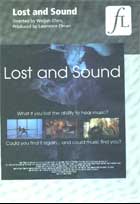
Lost and Sound 2011
Distributed by Filmakers Library, 124 East 40th Street, New York, NY 10016; 202-808-4980
Produced by Kat Mansoor and Lindsey Dryden
Directed by Lindsey Dryden
DVD, color, 76 min.
Sr. High - General Adult
Health Sciences, Audiology, Neurology, Music, Music Therapy, Education, Biology, Hearing
Date Entered: 06/04/2013
Reviewed by Lori Widzinski, Multimedia Collections and Services, University Libraries, University at Buffalo, State University of New YorkLost and Sound investigates the relationships between music, neurological stimulation, and hearing loss. Profiling three people of different ages, each experiencing differing types of hearing loss, director Lindsey Dryden follows them for two year, ultimately crafting a compelling documentary. Lost and Sound explores the impact of music in human life emotionally, psychologically and physically, and asks the question, if one loses hearing does that mean it is gone forever?
Framing the film are the everyday experiences of Holly, 12-years old at the end of filming, who lost her hearing from a bout of meningitis at the age of 14 months, and is an accomplished musician; Emily, a totally deaf young woman in her twenties who is pursuing a career in dance; and Nick, a middle aged music journalist and former music reviewer, who suddenly lost his hearing in one ear. The heart of the film centers on the ability of the brain to synthesize, comprehend, and retain music and how it manifests in the lives of the deaf and hearing impaired. The experts in the film are Dr. David Eagleman, Professor of Neuroscience at Baylor College of Medicine; and Dr. Nigel Osborne, Professor of Music at the University of Edinburgh. Dr. Osborne details fascinating hypotheses concerning the evolution of hearing from cells originating in the oceans millions of years ago into the current anatomical basis of human hearing. He expounds on the brain’s ability to retain music and how it could be interpreted that music, once learned or heard, never really leaves us. As we learn more about Holly, Emily, and Nick, the multi-sensory impact of music comes to light. Both Holly and Emily have cochlear implants and can hear to some extent. They both speak about the importance of music in their lives; the impact their hearing loss has on their families; and the environmental factors that influence how they interpret music. Nick’s work with Dr. Eagleton delves into the neuroscience of music, and how the brain works when we listen to music; and how it compensates for the loss of one of our senses by strengthening the other four. Our brains have the ability to reconstruct music, and Nick has worked hard to enjoy music as fully as he is able. While Nick may also be a candidate for a cochlear implant in his deaf ear, he decides not to pursue that path, thinking it will once again change how he perceives music, and he’s worked too hard to bring back what he already has.
The film is beautifully shot, the filmmaker’s choice of images to interpret sound visually are lovely. The music complements the film perfectly. It’s a bit long for classroom use at 76 minutes, and instructors can easily fast forward through some of the scenes of the three subjects enjoying their lives at home, school, or work, to fit into a typical class session. Lost and Sound is introductory in nature, and is recommended for college library collections in basic human biology, music and music therapy, and education.